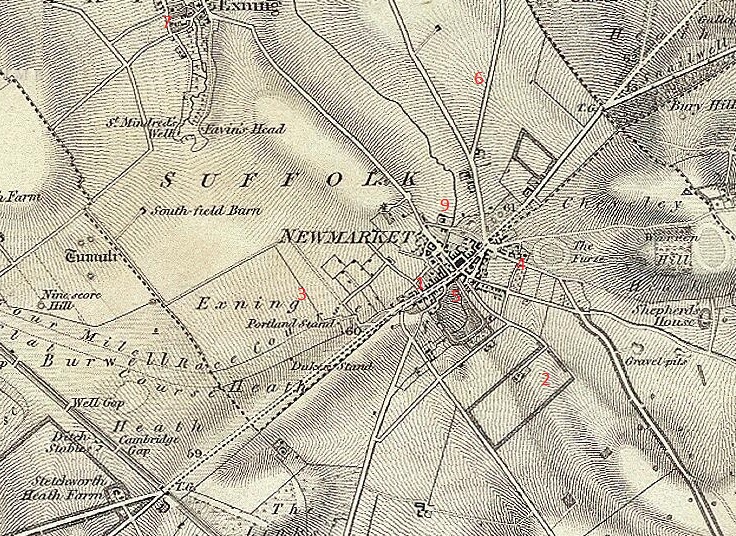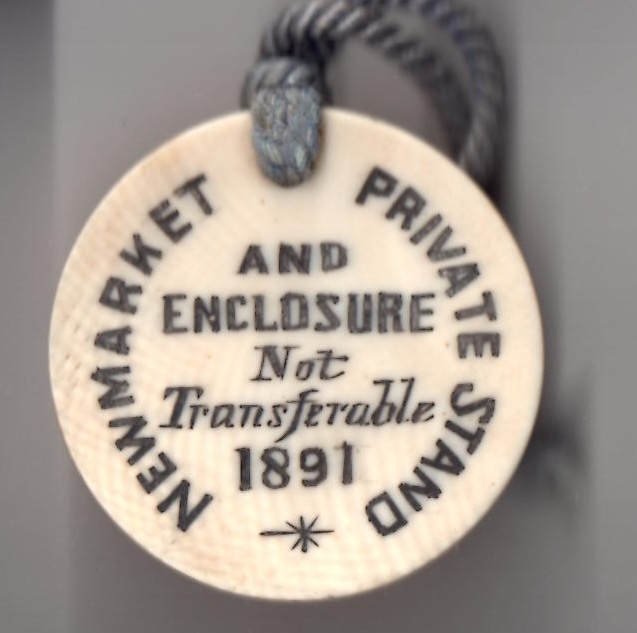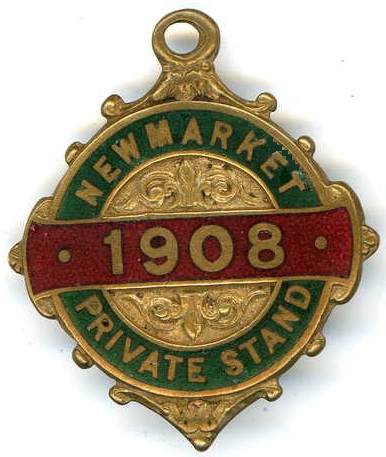The history of Bloomsbury House/Cottage and stables can certainly be traced back to 1865 as indicated by a datestone in the left-hand gable of the house, although there is every chance that the site was used for stabling before that date. The two-storey house of red brick, with slated roof, had stables to the rear, consisting of 4 loose boxes in the main area, with a further 2 pairs in an extension.
1873-September 1885 William Scott
William Harvey Scott, born in Thirsk, Yorkshire in 1820, was apprenticed to Sir Mark Wood's stable, and also qualified as a vet. He trained at Smitham Bottom before basing himself at Holywell in Flintshire for 2 decades. He then moved to premises at Plymouth Copse until 1873, when Scott transferred to Bloomsbury Cottage Stable. He owned and trained the winners of the 1865 Liverpool Spring Cup, the 1868 Ebor Handicap Fair Wind, and the 1871 Chester Cup Glenlivat. He remained at Bloomsbury Lodge until he became too ill to train in 1880, and died at Bloomsbury Cottage on 1 Sept 1885.
September 1886
An advert in the newspapers in September indicated that Bloomsbury Cottage, complete with stabling for up to 10 horses, was available to let from October 1886.
For over 4 centuries racing has been staged in Newmarket, but how have the racecourses evolved from an initial starting point at Fleam Dyke Pumping Station, some 8 miles from the town, with a winning post barely 200 metres from the town centre, into two world recognized, excellent racecourses and a universal acceptance that Newmarket is the Headquarters of racing?
To access an interactive racecourse map showing over 50 individually named racecourses CLICK HERE. The map will enable you to:-
1. Determine when extended races over 8 miles, 6 miles and 4 miles began to be replaced by the courses now visited by thousands annually;
2. Consider how the challenge of crossing the Devil's Dyke was overcome;
3. Contemplate why the town no longer has a steeplechase course despite having at least 5 courses during the past 2 centuries;
4. Examine the practicalities of having up to 48 starting posts and winning posts;
5. Appreciate that it was not financially viable to have an open racecourse spread widely across the heath, with a finishing post barely 200 metres from the town centre;
6. Research how and why the Cambridgeshire Handicap has been contested over 3 different courses.
NOTE: The map does not make mention of 2 particular courses:-
(i) Sefton Course (also known as the Cambridge Road Course)
Source: 1970 Raceform. Used from 1959 to 1975.
(ii) New Circular Course
The Circular Handicap was run on Friday 29th October 1875 on the New Circular Course of about two miles.
Source: London Standard (30th October 1875): ''the horses started near the Turn of the Lands, ran back way of the Cambridgeshire Course towards the Ditch, and afterwards proceeded down the side of the Tan Gallop, and turned into the Rowley Mile near the Bretby Stakes starting post, finishing at the stand at the end of the flat. Except in the hollow near the Cambridgeshire start the runners should have been visible all the way if the sky had been bright and clear''.
Another report hoped that the Circular Handicap would become a feature in future programmes, as it would be contested in front of the new grandstand which would be completed in about a year and would be able to accommodate thousands.
(I am grateful to Tim Cox for bringing attention to these 2 courses.)
Enjoy researching the intriguing history of Newmarket and its many racecourses.

1888-1899 George Ashby
In 1894 George Ashby was training a dozen horses at Bloomsbury Cottage Stables for the brewer Hamar Bass. A partnership which was rewarded with success in the 1896 Goodwood Stakes by Carlton Grange at 6/1 ridden by Allsopp, beating the Sam Loates ridden Quilon (100/3) and the Harry Grimshaw ridden Powick (8/1). Prior to this run Carlton Grange was unplaced in the Royal Hunt Cup behind Lord Rosebery's Quarrel. Ashby was disappointed when a number of horses, not owned by Bass, were moved from the Bloomsbury stable in 1895 and taken to be trained by A Taylor at Manton House Stables, Wiltshire. In July 1906 the Sporting Life listed all of the Newmarket Stables together with their respective trainers, and George James Ashby was listed at Bloomsbury Lodge.
Tom O Chaloner, born in 1866, was the oldest son of Tom and Ellen Chaloner, and trained at Middleham and Newmarket. When Tom senior died at the young age of 46 in 1886 his mother Ellen, just 43 at the time and with 8 children to raise, took over at Osborne House, successfully applying for a trainer's licence, although it appears Tom junior had to be the registered trainer. Indeed, one of the controversial winners trained at Osborne House was his first winner as a trainer, Jacob, who won 2 races on consecutive days at Hampton Court racecourse in 1886. He later went on to train at Stockbridge House from 1889, training Marco to win the 1895 Cambridgeshire for owner Mr Francis Luscombe, but also leased boxes at Bloomsbury Lodge, using it as an overflow yard.
1899-1901 Weston Goodwin
At the turn of the century Weston Goodwin trained at Bloomsbury Cottage as private trainer to the Duke of Devonshire, although it is unclear whether he shared the site with George Ashby. Weston was the son of William Goodwin, Classic winning trainer, and his wife Lizzie Goodwin. They had four children who were all involved in racing, but at some stage the marriage broke down and Lizzie remarried William Wright. William Goodwin, father of Weston, won the 1850 Epsom Oaks with Rhedycina (SR 1840) and the 1854 Epsom Oaks with Mincemeat (SR 1825). Head lad to Weston Goodwin was Lew Warner, who also took charge at the Rutland Yard which Weston used. In August 1899 M Michel Ephrussi appointed Weston as his trainer and he was installed at Bloomsbury Cottage, but had moved to Fitzroy House by 1902. After moving to Fitzroy House Weston's most prestigious winner was 1902 Eclipse Stakes winner Cheers owned by the Duke of Devonshire. In July 1906 the Sporting Life listed all of the Newmarket Stables together with their respective trainers. Weston Goodwin was listed at Fitzroy House, moving there in 1903 to continue training for the Duke of Devonshire after leaving Bloomsbury Cottage Stables. In October 1906 the Duke moved all of his horses from Weston Goodwin's charge, sending them instead to be trained by Sam Darling. In April 1908 Weston Goodwin married Miss Minnie Pennington at St Mary's Church, Newmarket at 8.45 in the morning.

1850 Epsom Oaks RHEDYCINA (SR 1840) 6/1 owned by George Hobson, trained by William Goodwin and ridden by Frank Butler
1854 Epsom Oaks MINCEMEAT (SR 1825) 10/1 owned by William Cookson, trained by William Goodwin and ridden by Jack Charlton
1902 Eclipse Stakes CHEERS owned by the 8th Duke of Devonshire, trained by Weston Goodwin and ridden by Danny Maher
1901-1903 Leandro Alvarez
Leandro Alvarez, son of the leading Argentinian trainer, initially trained in Montevideo before coming to England with Don Pio Torterolo. Although Torterolo returned to his native country soon afterwards, Alvarez remained and, at the turn of the century, took charge at Queensbury Lodge, and made use of nearby Bloomsbury Lodge. He celebrated his first winner on 25 October 1899 partnered by stable jockey Gomez, but bigger successes followed, including Epsom Lad, winner of the Eclipse Stakes at Sandown, and Black Sand who landed the 1902 Cesarewitch for wealthy owned J Buchanan (aka Mr T Kincaid). Leandro Alvarez returned to South America in 1904 and died suddenly on 28 April 1904. Queensbury Lodge and stables were still empty and available to let in summer 1904.
1901 Eclipse Stakes at Sandown EPSOM LAD 7/1 owned by Mr T Kincaid (aka J Buchanan), trained by Leandro Alverez and ridden by Gomez
1902 Cesarewitch Handicap at Newmarket BLACK SAND 8/1 owned by J Buchanan, trained by Leandro Alvarez and ridden by Kempton Cannon
1904-1919 George James Ashby, Sir William Bass
George James Ashby, born in Dullingham near Newmarket on18th July 1861, was the son of a labourer. After spending time assisting Mat Dawson he spent some time training at Bloomsbury Cottage Stables before joining John Dawson at Queensbury Cottage in January 1892. He then trained for Hamar Bass at Bloomsbury Lodge for a considerable period, but Bass died in 1898, after which his entire stud of horses was sold. At that point Bloomsbury Lodge was leased, but in the summer of 1904 Sir William Bass invited George Ashby to return to Bloomsbury Lodge, and he trained there for an extended period. However, in Summer 1919 Bloomsbury Lodge and its 9-box stables was put onto the market. George Ashby lived to the ripe old age of 86, dying on 5th March 1948.


In 1968 newspapers reported that George Blum, who trained at Bloomsbury Cottage Stables, had applied to extend his licence to include National Hunt horses. This request was specifically to enable him to train the jumpers Cardington Fair and Prospect Hill. Gerry Blum, who became an apprentice jockey at 14, and was responsible for the 1945 1000 Guineas winner Sunstream (SR 2032) when she was trained by Walter Earl, later went on to train in Newmarket for 28 years, and died in March 2015 aged 90.
June 2014
At some stage the Bloomsbury Cottage and stables site was redeveloped to build a number of houses. Bloomsbury Cottage was number 7 Fitzroy Street, and it sold in June 2014 for £350,000.



